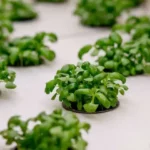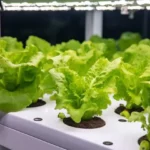If you’re seeking a clean and efficient way to grow delicious, crunchy lettuce, consider hydroponics a promising and viable option. Concerns about soil quality, destructive pests, or limited outdoor space have led you here to seek alternative methods for cultivating fresh greens. Well, buckle up because you’ll learn how to grow hydroponic lettuce and produce healthy greens in your home using efficient hydroponic techniques.
Lettuce plants grow well with a hydroponics system. First, set up your system (deep water culture, NFT, or store-bought plant germination kit), then select the best varieties of lettuce seedlings or seeds (butterhead, little gem, or loose-leaf lettuce). Maintain a perfect nutrient balance (EC of 1.2 to 1.5 mS/cm and pH levels of 5.5 to 6.5) for healthy, fast-growing greens.
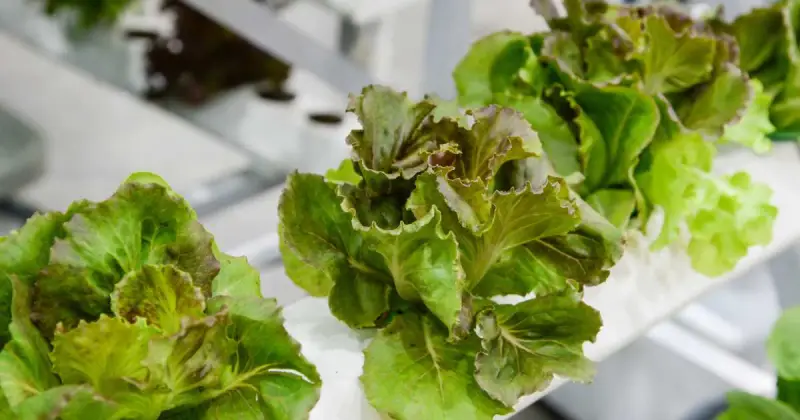
Throughout this article, you’ll gain insights into selecting the best lettuce varieties for hydroponic growth and the secrets to balancing nutrients for vibrant and robust hydroponic crops. I will guide you on how to choose and set up your hydroponic system to ensure a steady supply of fresh produce and the right timing to harvest your homegrown hydroponic lettuce.
Humble Highlights
- Discover how easy it is to develop delicious, crunchy, and nutrient-rich lettuce at home AND why hydroponic lettuce grows faster and conserves more water than traditional soil cultivation so you can always have an abundance of this ultimate crop!
- Save time by choosing these 5 best lettuce varieties to grow hydroponically so you can cultivate efficient and bountiful harvests.
- Save money by discovering the three critical pieces of hydroponic equipment you’ll need to grow exceptional lettuce AND this straightforward step-by-step process of how to germinate your crop so you can boost production – even if space is limited!
Advantages Of Growing Lettuce Hydroponically
While the traditional backyard method for growing plants has its merits, you’ll find that caring for lettuce hydroponically offers significant advantages, such as faster growth and water efficiency.
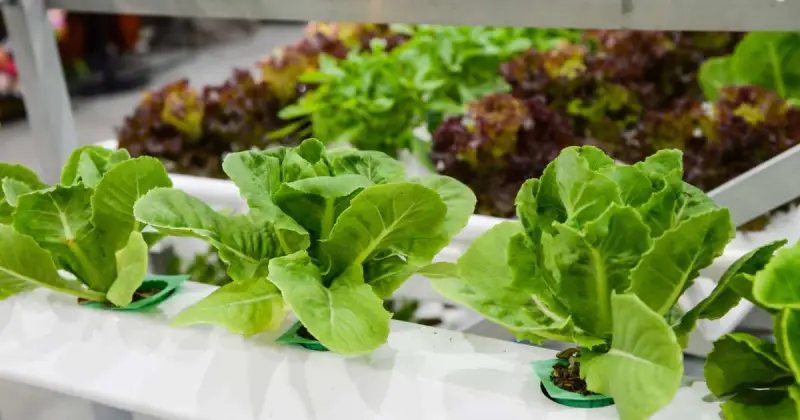
Hydroponics offers faster growth and water efficiency because it provides plants with precise and consistent access to nutrients, oxygen, and optimal environmental conditions. Plant roots are typically submerged or exposed to a highly oxygenated environment, which ensures that the roots receive an ample supply of oxygen, promoting healthy root development and enhancing nutrient uptake.
The benefits of hydroponic lettuce are clear: you’re engaging in a garden practice that maximizes yield while conserving resources. Hydroponic systems for lettuce optimize nutrient delivery directly to the plant roots, enhancing growth rates and producing healthier, more vibrant greens. 1
This approach to growing without soil eliminates many variables (pests, quality, diseases, weeds) that can lead to crop failure, ensuring a safer and more reliable harvest.
Moreover, hydroponic lettuce cultivation is remarkably space-efficient, allowing for outstanding production within a smaller footprint – a crucial consideration for urban growers and those with limited space.
Best Types Of Lettuce For Hydroponic Growers
Butterhead, romaine, and loose-leaf lettuce varieties are among the top choices for hydroponic cultivation due to their adaptability and growth efficiency. When selecting the best types of lettuce for your hydroponic system, consider these varieties:

- Butterhead Lettuce (Bibb Lettuce): Noted for its soft, buttery leaves and compact growth, butterhead is perfect for hydroponic lettuce gardens.
- Romaine Lettuce: This popular variety of hydroponic lettuce, with elongated head and sturdy leaves, is ideal for crisp salads and sandwiches.
- Loose-Leaf Lettuce: Loose-leaf lettuce varieties like Salad Bowls and Oak Leafs are the best options for hydroponic growing due to their tender leaves and ability to mature quickly (45 to 60 days) compared to others.
- Leaf Lettuce: Consider varieties like Black Seeded Simpson or Red Sails if you prefer larger leaves. These leaf lettuces can grow back multiple times when properly harvested, although the exact number may vary.
- Miniature Varieties: Lettuce like Tom Thumb or Little Gem are excellent options for hydroponics if you want to grow hydroponic lettuce in small spaces.
These lettuce varieties ensure a safe, efficient, and bountiful harvest in your hydroponic garden – even if you’re new to hydroponics! 2
Hydroponic Garden: Equipment You Need For Planting Lettuce In Hydroponic Setup
Once you’ve selected your lettuce variety, you must gather the essential equipment for your hydroponic system to ensure successful growth. Your hydroponic setup will depend on the types of hydroponic systems you choose – each with its specific requirements.
A reliable growing medium supports root development and seed germination, while an appropriate grow light ensures your plants receive the necessary light spectrum for photosynthesis. 3
Here is a table of basic equipment you’ll need:
| Equipment | Purpose |
|---|---|
| Hydroponic System | Houses and supports plant growth (e.g., deep water culture, wick system, or NFT system) |
| Growing Medium | Provides support and aeration for roots (e.g., coconut coir, perlite) |
| Nutrient Solution | Delivers essential nutrients to plants. A twin- or triple-pack solution are usually the best options as they are simple to mix and only require a few materials (container and stirrer). |
If you have a budget ($65 to $70), consider purchasing a store-bought germination kit. You can find these setups conveniently online or at your big-box retail stores. These kits allow your leafy crop to proliferate and help you grow your lettuce indoors.
Time For Lettuce To Grow In A Hydroponic System
After setting up your hydroponic system, you’ll find that lettuce can reach harvest-ready status in as little as 3-4 weeks for leaf varieties and 5-6 weeks for whole heads of lettuce. To ensure optimal growth, consider the following hydroponic lettuce needs:
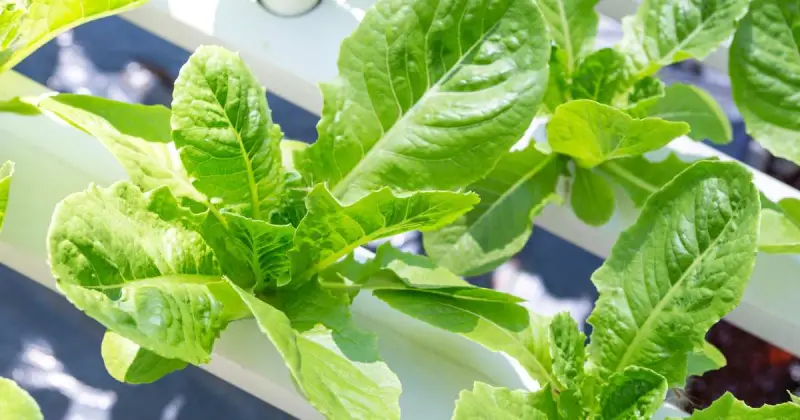
- Nutrient Solution: Maintain a balanced nutrient solution tailored for leafy greens to fulfill their mineral requirements (phosphorus, nitrogen, potassium, calcium, and magnesium) in the hydroponic environment. 4
- Lighting: Provide ample light for 10-14 hours daily to support photosynthesis, crucial for growing lettuce in a hydroponic system. It ensures an extended period of photosynthesis, allowing the plants to generate sufficient energy and multiply without natural sunlight.
- Temperature Control: Keep the environment between 60-70°F (15-21°C) because extreme temperatures can impede growth or induce bolting – a process whereby your crop turns to seed.
Remember, most lettuce varieties will regrow three to five times, so cut them properly by trimming the leaves close to their base and a few inches above the soil line. Cutting your lettuce this way increases your crop’s chances to grow for additional harvests.
EC (Electrical Conductivity) measures the concentration of dissolved ions, primarily salts, in a nutrient solution used in hydroponics. It is essential because it indicates the solution’s strength or how much nutrient content it contains.
For example, different growth phases (e.g., vegetative, flowering) may require adjustments in nutrient concentration, and EC helps ensure precise control over nutrient delivery.
Cultivating home-grown lettuce is one of the most rewarding crops a backyard gardener can produce. Lettuce is quick-growing, enjoys some shade, and is relatively tolerant in most climates before the onslaught of summer. Check out this informative video below, which details how you can start growing lettuce hydroponically quickly and easily!
Key Steps To Grow Hydroponic Lettuce At Home
Lettuce is a cool-season crop and is one of the popular hydroponic crops to grow. However, for you to successfully grow them at home, you’ll have to follow several key steps, each crucial to the health and productivity of your plants.
- Begin by germinating lettuce seeds in a suitable growing medium like Rockwool or coconut fiber.
- If you use lettuce seedlings from a nursery, transplant them into your growing medium once they show their true leaves.
- Once the seedlings have developed mature lettuce leaves and roots, you can begin transplanting them into your hydroponic garden.
- Maintain the temperature for hydroponic lettuce between 60°F and 70°F (15°C to 24°C), with humidity levels around 40% to 50%.
Ensure your lettuce receives at least 12 to 16 hours of light daily. It can be from sunlight or grow lights such as light-emitting diodes (LED) or high-intensity discharge lights (HID). 5
When choosing lettuce varieties, it is recommended to select those belonging to the head lettuce varieties (Butterhead, Iceberg, and Romaine lettuce) as they are best suited for hydroponic cultivation to ensure robust growth.
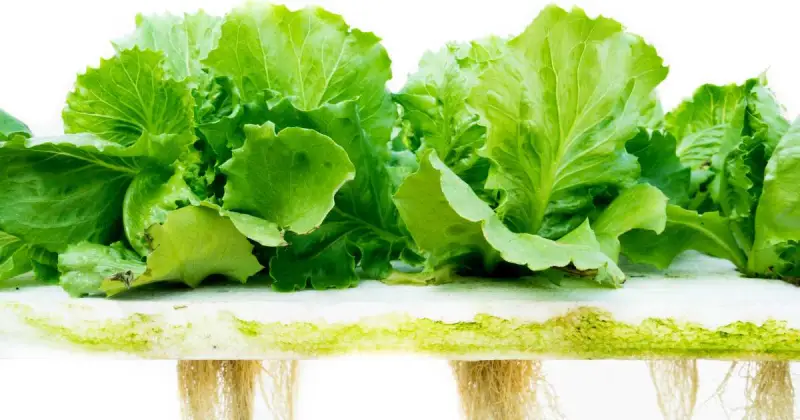
Conclusion
Growing hydroponic lettuce is a journey where practicality meets eco-friendliness. Choosing the appropriate varieties and equipment enables you to harvest your lettuce in just a few weeks. This method offers numerous benefits, such as accelerated growth, efficient water usage, higher yields, lowered risk of crop failure, and space optimization.
When cultivating hydroponic lettuce, consider varieties like butterhead, romaine, loose-leaf, leaf, or miniature types, and ensure you have the necessary equipment, including a hydroponic system, appropriate growing medium, and a customized nutrient solution tailored to your chosen setup.
It’s essential to keep up with system maintenance and nutrient levels to ensure your plants thrive. By embracing this method, you’ll enjoy the unique satisfaction of eating lettuce you’ve grown while doing your part for the environment. So, keep at it; your efforts will yield fresh, healthy greens from your home.
Do you currently cultivate crunchy, delicious lettuce hydroponically at home? Let us know what varieties work best for you by dropping a line in the comment section below!
SOURCES
- National Library Of Medicine, National Center For Biotechnology Information – Comparison Of Land, Water, And Energy Requirements Of Lettuce Grown Using Hydroponic vs. Conventional Agricultureal Methods
- IOP Science – The Effect Of Hydroponics Systems On The Growth Of Lettuce
- United States Department Of Agriculture – National Agricultural Library – Hydroponics
- MDPI – A Review On Hydroponics And The Technologies Associated For Medium And Small-Scale Operations
- Wikipedia – Organic Hydroponics


